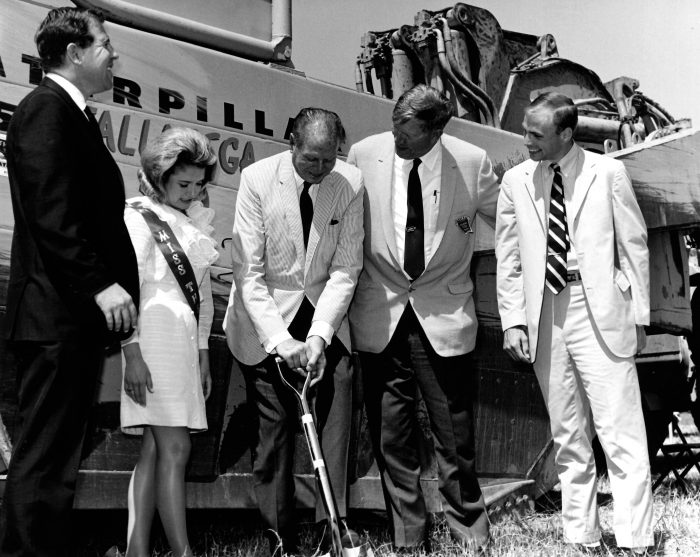
Years ago when the late William H. G. “Big Bill” France was asked why he decided to locate the world’s greatest motorsport facility near the northeastern Alabama community of Talladega at a ghostly abandoned Eastaboga Airfield, he said it was because the spot at the foothills of the Appalachians is centrally located to millions of people.
For the man who also built Daytona International Speedway, Alabama International Motor Speedway – today known as Talladega Superspeedway – would be bigger, faster, and more accessible.
“We could have built a major speedway almost anywhere in the country,” said France, who was both the founder of NASCAR as well as the president of the sanctioning body and International Speedway Corporation that controlled both the Daytona and Alabama facilities. “We considered numerous sites before we finally selected Talladega.”
NASCAR pioneered stock car racing and ushered in the superspeedway era when the Darlington International Raceway opened in Darlington, SC, in 1950. The new sport continued to flourish with more major facilities opening throughout the South in the late 1950s, including the 2.5mile venue in Daytona that opened in 1959.
“We had a Talladega in the back of our minds for quite some time,” France said of the facility that opened in September of 1969 with a doubleheader weekend, featuring the Talladega 500, “but it wasn’t until Bill Ward, a businessman in Anniston, AL, entered the picture that the possibilities began to materialize.”
“You find me 1,000 acres of land close to an interstate, and I’ll come look at it,” Ward, who still sells insurance in nearby Anniston, said of his marching orders from France. Ward had a property in mind near his native Atalla, but it was a no-go. That’s when he remembered the Eastaboga Airfield, built to train pilots in World War II and eventually sold by the Air Force to the City of Talladega for $1.
Ward went to Talladega city leaders and proposed the race track, “and they told me I was crazy,” laughed Ward. But after France hosted those officials in Daytona, “They wouldn’t leave me alone,” Ward says. “They said ‘Get that man up here and let’s talk about that race track.’”
Through Ward’s efforts, France looked over the almost abandoned airport which was once used by the Air Force and later by the city of Talladega. France and the Airport officials discussed by the possibility of building a major racing facility on the property, but the idea appeared doomed due to circumstances beyond the control of officials.
The late O.V. Hill Sr., a native of Talladega and a man possessed with as much determination as France, saw the potential that a major racing facility held for the area. Hill, an industrial specialist at Auburn University, organized an influential group of civic and government leaders and the group amended legislation that eventually led to the track construction and the building of necessary roads for handling the traffic.
France named O.V. “Dell” Hill Jr., Director of Finance, and appointed Roger Bear, Director of Promotion, and the “dream” began to come to life.
Dr. James L. Hardwick, Mayor of the city of Talladega, was influential in organizing community leaders in support of the project. The Talladega Airport Board members dedicated their efforts to obtaining FAA and Defense Department approval.
France gained the valuable assistance of Travis McCraig, Talladega real estate developer and motel owner, to overcome the final hurdle. McCraig introduced France to John and Bill Moss of the Moss-Thornton Construction Co. of Leeds, Alabama, and the officials of the huge engineering and construction firm, immediately joined in sharing the enthusiasm France held for the development.
Ground was broken for Alabama International Motor Speedway in May of 1968, and another “impossible dream” was destined to become a reality.
Where else but Talladega?
“Talladega is located within a 300-mile radius of a population of 20 million people,” France said, “and it’s stock car racing country. We wanted Talladega because we wanted to take the world’s best racing to the people. That’s why we built the world’s greatest speedway where we did.”
The result was a track that is a tri-oval layout at 2.66 miles in length and banked 33 degrees – both the biggest in NASCAR. Mr. France’s message to fans was simple.
“We tried to provide the fastest, safest, most complete racing facility in the sport,” France said at the time, “and we feel like we have anticipated every possible need for the competitors, their crews and the spectators.
“As visitors of Alabama International Motor Speedway and supporters of our great sport of stock car racing you are participating in the beginning of what I think will become the World’s No. 1 automotive showplace. We are happy to be opening the world’s fastest closed Speedway in the heart of Alabama. I think you will agree that this is a beautiful setting for a major sports facility. The people of this area join me in welcoming you.”
And, the same is true today. After five glorious decades of motorsports history, France’s vision will continue with the Sugarlands Shine 250 for the NASCAR Gander Outdoors Truck Series on Saturday, Oct. 12, and the 1000Bulbs.com 500 for the Monster Energy NASCAR Cup Series on Sunday, Oct. 13 – both are crucial NASCAR Playoff events. For ticket information and to learn more about the Talladega Garage Experience, log onto www.talladegasuperspeedway.com or call 855-518-RACE (7223).
TSS PR





